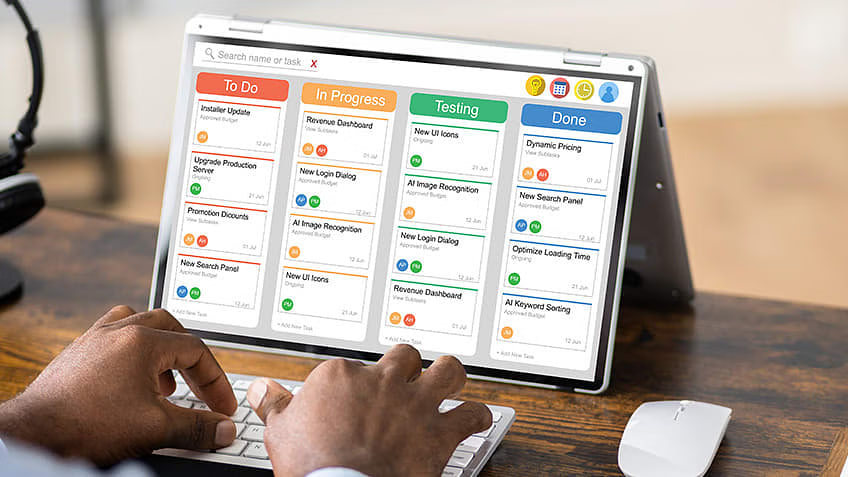13 Ways to Strengthen Your Client Relationship
The success of small businesses depends on managing clients and maintaining a good and close relationship with them. These close relationships encourage clients to work with you on future projects and refer you to their acquaintances.
Strengthening the relationship with clients aims to gain their trust and demonstrate the ability to perform the required tasks efficiently, which encourages them to work with you on future projects.
Building relationships with clients
Here are 13 ways to strengthen the relationship with clients:
1. Communicate with them effectively and regularly
Priority should be given to effective communication at the appropriate time and not neglected when busy completing the required work.
Therefore, focus on clear and regular communication while working on the project, and you should also make it clear to the client from the beginning that you will work with him to develop value statements based on his business goals and evaluate the amount of progress made during the implementation stages according to this agreed-upon data.
Communication with clients should not exceed the acceptable limit to the point of encroaching on your comfort time or causing a decrease in your productivity. Still, you demonstrate your interest in the work and satisfy clients when you can communicate when needed.
On the other hand, the relationship with the client can be strengthened by providing comfortable conditions that reassure him and encourage him to communicate frankly and honestly. You must, however, take his thoughts and concerns seriously in order to succeed in strengthening your relationship with him.
2. Highlight positivity and self-confidence
The independent consultant assumes a large number of responsibilities that exhaust him, drain his energy, and expose him to high levels of psychological stress. However, he must be positive and enthusiastic when communicating with his clients. Enthusiasm is one of the most prominent personal traits that attract attention, attract clients, and encourage them to cooperate with you.
3. Personalize the relationship with the client
The relationship with the client is professional, but it improves greatly when personalized and humanized. The level of acceptable closeness depends on a set of factors such as the type of work sector, the nature of the client, and his personal qualities. You can check on the client's children if he is married, for example, or send him an article discussing one of his interests if you are close to him.

4. Explain the stages of work
The client may face difficulty in understanding the work stages and following the progress of the project if he does not have a clear idea of your field of specialization, and here your role in providing information that helps him understand the nature of your work and feel confident during the process emerges.
Therefore, you must explain to the client what you did, the reason that prompted you to take this action, and the stages of the decision-making process so that he can follow all the implementation details.
5. Share professional opinion
You must gain the client's trust and convince him of your experience to succeed in strengthening your relationship with him in the long term. For this reason, it is recommended that professional opinions and points of view be shared with complete frankness and transparency in a way that serves the interest of the project.
You should not hide your frank opinion about the project or avoid engaging in difficult conversations. You should be satisfied with reassuring the client and conveying good news only to maintain the cooperative relationship between you and your reputation in the market.
Still, you must present your professional opinions with transparency and objectivity and highlight your desire to achieve high-quality results to gain the client's respect and trust.
6. Deliver beyond expectations
The best way to strengthen the relationship with clients is to build a good reputation that proves your experience and ability to achieve impressive results, but never promise the client impossible results to preserve your reputation in the market.
It is advisable to agree with him on logical results to accomplish what is required and deliver the final project according to the agreed standards, as well as to convince him to continue working with you.
7. Considering partial and comprehensive goals
You should inquire about partial and comprehensive goals in both the short and long term. This requires you to inquire about current projects' purpose and role in achieving the company's vision and mission. It is preferable to also inquire about the culture of the client's company to strengthen your relationship with him and enhance mutual trust and respect between you.
8. Diversify working methods
A successful consultant uses methods, work procedures, and means of communication that suit the client and does not apply the techniques that he is good at using with all clients. You must use the means of communication that the client prefers, such as video communication, for example.
As client experience expert Matthew Small says: “Communication styles vary from person to person, and client interaction styles need to take these differences into account.
Some people prefer to read calculations and scientific facts, while others prefer discussions and conversations. The key is to be flexible and not prepare a conversation in advance, but rather to define the purpose of the communication process and the information you intend to obtain from the client conversation.”
Try to invest your emotional intelligence in guessing the reasons that drive the client to approach the subject in a certain way so that you can change your communication and interaction style accordingly.
9. Be humble
A capable consultant knows that the client knows best in his field of work. He may know the best way to deal with key stakeholders and leverage the market situation to achieve the project goals.
Therefore, you should express your respect and appreciation for the client’s expertise in the company’s situation and the circumstances of the work sector, and do not be shy about asking questions, agreeing on the appropriate way to deal with the issue, and suggesting solutions that are appropriate for the company’s circumstances.
10. Use project implementation tools
Project implementation procedures should be organized using tools that help deliver work professionally from the first stage to the final stage, including submitting project proposals, contracting procedures, preparing a statement of work and client reports, and issuing professional invoices.
These tools help increase the level of professionalism and enhance business skills, increase transparency, and enable the possibility of following up on project implementation.
You should understand the client's needs and meet them by taking simple steps such as delivering the project in a visually attractive format, or presenting materials personally and adding demonstrations on how to use the product or service, or adding features that enhance the quality of the final results.
Loyal clients can be distinguished by offering a symbolic gift after achieving important achievements or during occasions such as holidays, as this method contributes to strengthening the professional relationship.
That is, you should invest any available opportunity to provide more than the client's expectations to gain their appreciation and strengthen your relationship with them.

11. Modify work procedures
Boundaries should be set within the framework of the relationship with clients, but additional efforts sometimes contribute to improving the results of cooperation. Therefore, you should adhere to the boundaries on the one hand, and look for opportunities to improve the quality of the results on the other hand.
Work procedures should be adjusted according to the client’s circumstances and needs, as some clients prefer to intervene and follow up on all stages of the process on the ground. In contrast, others prefer to see weekly reports summarizing the work accomplished. Remember that communication is essential to build trust and strengthen client relationships. For this reason, it is advisable to talk to the client and inquire about his needs and preferred working methods so that you can take them into account during implementation. Listening and paying attention helps to gain the client’s respect and appreciation.
12. Request feedback
Requesting feedback allows the client to express their opinion on how services are provided and suggest new working methods to improve the quality of procedures. This method helps improve the relationship with clients and shows your appreciation for their opinions and interest in the quality of your services.
Surveys can be prepared using digital platforms such as Qualtrics or sent as a file that allows clients to answer a set of questions and provide general feedback. You should thank clients for providing their answers and express your appreciation for their time after receiving feedback.
13. Stay in touch with clients
Try to stay in touch with clients after the project ends to maintain your relationship with them by sharing pioneering content with them, informing them of your new skills, and the achievements you have made with your new clients. This method effectively maintains your relationship with the client and prepares the appropriate conditions for future projects with him.
In conclusion
the consultant needs to strengthen his relationship with clients to succeed in achieving the desired results and ensure more opportunities for cooperation with them in their future projects.
The article presents 13 ways to help strengthen relationships with clients and secure job opportunities in their future projects.
Ads space
Latest Articles
Stay up-to-date with the latest
Be aware of the latest articles, resources and upcoming courses









